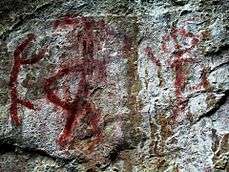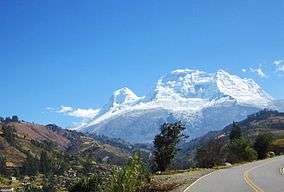Huascarán National Park
| Huascarán National Park | |
|---|---|
|
IUCN category II (national park) | |
|
Mount Huascarán, landmark and namesake of Huascarán National Park | |
 | |
| Location | Ancash, Peru |
| Nearest city | Huaraz, Ancash |
| Coordinates | 9°20′0″S 77°24′0″W / 9.33333°S 77.40000°WCoordinates: 9°20′0″S 77°24′0″W / 9.33333°S 77.40000°W |
| Area | 340,000 hectares (1,300 sq mi) |
| Established | July 1, 1975 |
| Governing body | SERNANP |
| Type | Natural |
| Criteria | vii, viii |
| Designated | 1985 (9th session) |
| Reference no. | 333 |
| State Party | Peru |
| Region | Latin America and the Caribbean |
Huascarán National Park (Spanish: Parque Nacional Huascarán) is a Peruvian national park that comprises most of the mountain range known as Cordillera Blanca (the world's highest tropical mountain range) which is part of the central Andes, in the region of Ancash.[1][2] The park covers an area of 340.000 ha (ca. 3.400 km2) and is managed by the Peruvian Network of Protected Natural Areas: SERNANP.[1] Huascaran National Park, designated as a World Heritage Site in 1985 by UNESCO,[3] is also a well-known mountaineering spot and harbors a unique biodiversity with emblematic species of plants such as the Queen of the Andes, trees of the genera Polylepis and Buddleja,[4] and animals such as spectacled bears, condors, vicunas and tarucas.[4]
History
The efforts to protect this area start in 1960, when Senator Augusto Guzmán Robles proposed the Peruvian Congress a bill for the creation of Huascarán National Park.[4] In 1963, the Forest and Hunting Service (Servicio Forestal y de Caza) presented a preliminary project for the delimitation of the Cordillera Blanca National Park, covering an area of 321,000 hectares.[4] On February 18, 1966 a government resolution prohibiting the logging and hunting of native species in the area of the Cordillera Blanca was issued.[4] Later that year, the Patronage of Huascarán National Park was formed in Yungay.[4] In 1967, Curry Slaymaker and Joel Albrecht, Peace Corps volunteers, formulated delimitation proposal on an area of 85,000 hectares; and simultaneously, the Forest Regional Service of Huaraz established the vicuña and queen-of the-Andes surveillance zone for an area of approximately 10,000 hectares.[4] Finally, on July 1, 1975 Huascarán National Park was created by decree No. 0622-75-AG, with an extension of 340 000 hectares.[1][4]
In 1977, UNESCO recognized Huascarán National Park as a Biosphere Reserve, which covers the Santa River valley, well beyond the park's boundaries, encompassing many villages and towns.[5] In 1985 the park was declared a World Heritage Site.[5]

Geography
Huascarán National Park protects the Cordillera Blanca ("White Mountains"), which is the World's highest tropical mountain range.[3] Located in the central Peruvian Andes, the park's 340,000 hectares[1] cover an elevational range from around 2,500 m to the several snow-capped peaks above 6,000 m.[3] One of those peaks is Huascarán, Peru's highest at 6,768 m.[3]
The geographical features inside the park include: U-shaped valleys, snow-covered peaks, 660 tropical glaciers, 300 glacial lakes and high plateaus intersected by deep ravines with torrential creeks.[1][3][4]
Climate
The climate of the park is characterized by two stages during the year. This depends on two major factors: the warm, humid winds from the Amazon Basin, which generate abundant rain between December and March; and a pronounced dry period between May and October, with sunny days that reach 25 °C and nights of intense cold during which temperatures can drop below 0 °C, and well below that at higher altitudes.
Ecology

The valleys and lower mountain slopes are covered with scattered high andean forests and puna grassland.[1][4]
Fauna
More than 120 bird species have been reported in this area including the Andean condor, the torrent duck, the puna tinamou, the brown pintail, the Andean crested duck, the giant hummingbird, the yanavico, the white-tufted grebe, the giant coot, the chiguanco thrush and the Andean gull.[1][4]
More than ten species of mammals have been observed in the park, several of them endangered, including the the colocolo, the Andean mountain cat, the spectacled bear (mostly seen in the Llanganuco and Potaca sectors), the taruca deer (with disperse populations in the northern side of the park), the vicuña (native in the southern section of the park, introduced from other regions in the Llanganuco sector), the white-tailed deer, the puma, the northern viscacha, the long-tailed weasel, the hog-nosed skunk and the Andean fox.[1][4]
Flora
Some 779 plant species have been identified inside the park, being the queen of the Andes (Puya raimondii) one of the most representative and an object of conservation.[1] Populations of queen-of-the-Andes can be found at the Carpa and Queshque valleys.[1]
The park protects forests of quishuar (Buddleja) and queñua (Polylepis) trees, which are mostly located north of the Llanganuco area. High elevation grasslands and meadows can be found over 4500 m of elevation.[1]

Activities
Visitors to the park can enjoy activities such as mountain biking, skiing, mountaineering, trekking and cultural tourism.[1] Huascarán has 25 trekking routes and 102 mountaineering spots.[1]
There are 33 archaeological sites within the park, which include: cave paintings, ancient settlements, terraces for agriculture, tombs, fortresses and irrigation works.[1] There's also a pre-columbian road between the towns of Olleros and Chavin.[1]
See also
References
- 1 2 3 4 5 6 7 8 9 10 11 12 13 14 15 "Huascarán - Servicio Nacional de Áreas Naturales Protegidas por el Estado". SERNANP (in Spanish). Retrieved 2016-05-29.
- ↑ Smith, David N. (1988). Flora and vegetation of the Huascarán National Park, Ancash, Peru: with preliminary taxonomic studies for a manual of the flora (Ph.D. Thesis). Iowa State University.
- 1 2 3 4 5 "Huascarán National Park". unesco.org. UNESCO.
- 1 2 3 4 5 6 7 8 9 10 11 12 "Parque Nacional Huascarán (in spanish)" (PDF). parkswatch.org. Parkswatch.
- 1 2 "21 World Heritage Sites you have probably never heard of". Daily Telegraph.
External links
| Wikimedia Commons has media related to Huascarán National Park. |
- Huascaran National Park. Official site (in Spanish)
- Huascaran National Park. Map.
- Official UNESCO website entry
- World Conservation Monitoring Centre

